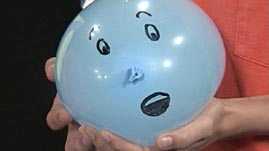Teachers' Domain - Digital Media for the Classroom and Professional Development
User: Preview


Source: ZOOM
Balloon Brain: Designing a Helmet (Document)
(electricity crackling)
CAROLINE: This is Chubby Brain.
ESTUARDO: And this is Pudge Brain.
GARRETT: Since they're water balloons, these brains, like our own brains, are pretty delicate. So our challenge today is to build a skull to protect them.
ALINE: Stephanie C. of Katy, Texas, did this experiment at school to learn how our skulls protect our brains. We're allowed to use any of these materials, but our skulls can't be more than two to three inches thick, and they can't cover the faces of our balloons.
CAROLINE: Later, Kortney will test out our designs by throwing them against this wall and seeing if they survive. Okay, guys, let's test it out.
ESTUARDO and ALINE: Okay.
CAROLINE: All right, so I think what we should probably do first is maybe layer the balloon with cotton balls just for protection.
ESTUARDO: I think we should do soft right here on the... and then we should keep on working up to thicker stuff.
GARRETT: What if we, like, cut an egg carton? You see these, like, bottom...?
CAROLINE: Yeah.
GARRETT: What if we, like, cut those off...
CAROLINE: Oh!
GARRETT: …and stuck them to it? Then stick it on around it.
CAROLINE: That is such a good idea.
GARRETT: Then it will hit this, and even less damage will be inflicted.
CAROLINE: Awesome— high five— that's awesome.
ALINE: Okay. Oh, he's wicked heavy.
ESTUARDO: We really need to make it tight so he has no chance of falling.
CAROLINE: He's so cute.
ALINE: Are you guys done?
CAROLINE and GARRETT: Yep.
ESTUARDO: Let's test them out.
ALINE: Let's go. Okay, ready? Ready, ready, ready?
CAROLINE: Let's back up, then.
ESTUARDO: I'm scared.
GARRETT: Ready?
CAROLINE: Chubby!
ALL: One, two, three.
CAROLINE: (shrieks)
GARRETT: It survived! It survived!
CAROLINE: Oh, Chubby!
GARRETT: Oh, Chubby! Ready? Oh, my...
ALL: One, two, three.
GARRETT: Oh, man!
ESTUARDO: No...!
ALL: (laughing)
GARRETT: Oh, little Chubby! (pretending to cry)
CAROLINE: Our balloon brain survived, because it stopped gradually as it hit the wall. The cotton balls that were directly next to the balloon helped slow it down, and the egg crates around the balloon helped to distribute the force around the whole balloon so that the force of the hit wasn't on just one area of the balloon. These two things helped make the force on the balloon much smaller when it hit the wall, so the balloon didn't break.
ALINE: Our balloons broke because our faces weren't padded. Without this protection, the force from the floor that stopped the balloon also broke it.
ALL: (exclaiming)
GARRETT: Bicycle helmets are engineered to do the same thing as skulls we build for the water balloons. They give extra protection to our head. The foam inside a bicycle helmet slows your head down and prevents it from colliding suddenly, and that means less force on your head.
CAROLINE: The stiff outer shell distributes the force throughout the helmet, so each part on your head takes a little bit of the force, instead of having a lot of force on just one spot. This is why it's so important to wear a helmet when you ride a bike.
ESTUARDO: Experiment with the balloon brains at your home and see if yours can survive more throws than ours did.
 Loading Standards
Loading Standards Teachers' Domain is proud to be a Pathways portal to the National Science Digital Library.
Teachers' Domain is proud to be a Pathways portal to the National Science Digital Library.
